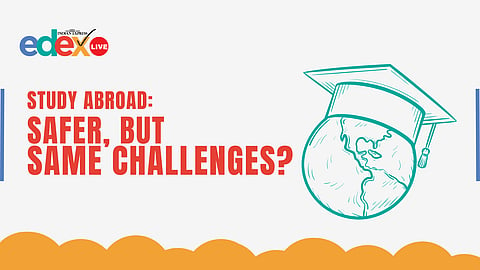

Despite tightening visa norms in countries such as the United States of America (USA), Canada, and Australia, Indian students continue to choose these destinations for their higher education.
With over 1.3 million Indian students among other international students, it would appear that Indians have learnt to weather torrential visa regimes and remain resilient in their pursuit of international education.
However, despite their persistence, international students’ safety remains a pressing concern. According to data from the Union Ministry of External Affairs, Government of India, from April 2025, there have been 91 violent attacks against Indian students since 2020, in which there were 30 fatalities.
Such incidents could discourage students from choosing these countries for their education, thus placing their international student markets in jeopardy. To illustrate, these countries have over 6 million international students, who contribute nearly $300 billion to their economies.
To make their time in the countries safer, several universities abroad and host countries alike are deploying several initiatives for international students, a report by international student recruitment agency Career Mosaic finds.
Drawing from data from 41 different countries, the International Student Safety Report 2025 highlights how universities are implementing several measures to ensure the safety of foreign students on their campuses.
“The idea behind this report was to step back from anecdotal fears and look at what the data really tells us,” said Abhijit Zaveri, founder, Career Mosaic.
Student safety a priority for universities
The report notes that foreign universities are investing heavily in safety initiatives so that they remain popular destinations in the global education market, maintain their financial stability, and strengthen their cultural diversity. Moreover, for host countries, the well-being of international students is an important diplomatic tool to maintain good relations with the countries they are from, as well as their global standing.
As a result, universities and countries have several initiatives to help international students feel more comfortable and fit into their new environments.
Universities globally take collective measures to ensure safety
For instance, universities in the USA and the United Kingdom (UK) frequently offer orientation classes for international students in collaboration with law enforcement agencies, including issues such as personal safety, local laws, and emergency contact information, to help them overcome the culture shock of another country and get them accustomed to the land. This prevents cultural misunderstandings and promotes proper public behaviour among international students.
These sessions also have workshops on using the local public transport systems and their ticketing processes.
In the UK, Students are also provided access to maps, guides and transportation apps to help them avoid potentially unsafe locations, while the University of Melbourne, Australia, offers them free or subsidised travel passes to prevent ticketing violations.
To combat isolation faced by international students due to an initial lack of community and support systems, universities in Canada, the United Kingdom, and Australia are using 24-hour helplines, apps such as My SSP and SafeZone, escorted night travel, and peer-led buddy systems.
Universities are also expanding culturally competent counselling, wellness initiatives, and virtual mental health apps like TimelyCare to better meet the requirements of international students.
Further, universities are raising more awareness on student victimisation and its signs, boosting community engagement initiatives through student associations and neighbourhood watch partnerships, and investing in safety resources for international students to feel safe, and setting up confidential channels to report crimes and incidents of discrimination against them.
“Encouraging peer-led support systems and fostering a culture of trust through outreach programs will help students feel more supported in reporting issues,” Zaveri told EdexLive.
Some gaps still leave international students vulnerable
While these measures helped decrease the number of incidents against international students, the report points to several hindrances to their safety that persist.
For instance, several international students are susceptible to several forms of housing insecurity. These include scams, housing shortages, exploitation by landlords, disparate tenant rights, overcrowding and unsafe housing conditions.
Moreover, the report observes that violence, discrimination and hate crimes against international students in these countries remain high. In 2021, hate crimes against Asians in the US increased by 150 per cent, while 45 per cent of East and Southeast Asian students in the UK reported experiencing hate crimes. Of these, female and LGBTQ+ students are even more vulnerable. To make things worse, most of these incidents go unreported due to stigma and a lack of trust in institutions.
Optimism in a grim climate
The report further shows 663 student deaths in 41 countries, with the largest numbers in Canada (172), the USA (108), the UK (58), Australia (57), Russia (37), and Germany (24).
It has also been discovered that less than 40 per cent of international students use campus services, whereas approximately 20 per cent of first-year students exhibit indications of prevalent mental health illnesses.
However, despite these problems still festering, the report has an optimistic outlook, as universities are working to close these gaps.
“Yes, there are still preventable risks like scams or cultural discrimination, but universities and governments are actively closing those gaps,” Zaveri said, adding that studying abroad is safer and more viable today than it was a decade ago.
Changing global safety standards for students
“Countries like the USA, Canada, the UK, and Australia have made remarkable progress in setting global safety standards. These countries offer robust safety measures, including emergency support services, mental health initiatives, and anti-discrimination programs, positioning them as exemplary models,” he further stated.
Zaveri advises students who want to study abroad and their parents to know and acquire more information on the safety initiatives and protections for international students at universities.
“Reaching out to alumni and current students for feedback, along with consulting official university resources on housing regulations and anti-discrimination policies, will help ensure they make informed choices,” he explained.
